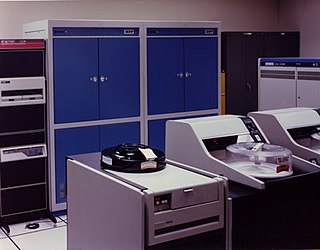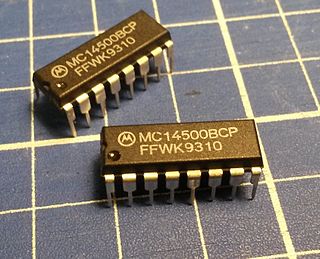
A central processing unit (CPU), also called a central processor, main processor or just processor, is the electronic circuitry that executes instructions comprising a computer program. The CPU performs basic arithmetic, logic, controlling, and input/output (I/O) operations specified by the instructions in the program. This contrasts with external components such as main memory and I/O circuitry, and specialized processors such as graphics processing units (GPUs).

Symmetric multiprocessing or shared-memory multiprocessing (SMP) involves a multiprocessor computer hardware and software architecture where two or more identical processors are connected to a single, shared main memory, have full access to all input and output devices, and are controlled by a single operating system instance that treats all processors equally, reserving none for special purposes. Most multiprocessor systems today use an SMP architecture. In the case of multi-core processors, the SMP architecture applies to the cores, treating them as separate processors.

A Connection Machine (CM) is a member of a series of massively parallel supercomputers that grew out of doctoral research on alternatives to the traditional von Neumann architecture of computers by Danny Hillis at Massachusetts Institute of Technology (MIT) in the early 1980s. Starting with CM-1, the machines were intended originally for applications in artificial intelligence (AI) and symbolic processing, but later versions found greater success in the field of computational science.
Thinking Machines Corporation was a supercomputer manufacturer and artificial intelligence (AI) company, founded in Waltham, Massachusetts, in 1983 by Sheryl Handler and W. Daniel "Danny" Hillis to turn Hillis's doctoral work at the Massachusetts Institute of Technology (MIT) on massively parallel computing architectures into a commercial product named the Connection Machine. The company moved in 1984 from Waltham to Kendall Square in Cambridge, Massachusetts, close to the MIT AI Lab. Thinking Machines made some of the most powerful supercomputers of the time, and by 1993 the four fastest computers in the world were Connection Machines. The firm filed for bankruptcy in 1994; its hardware and parallel computing software divisions were acquired in time by Sun Microsystems.

Parallel computing is a type of computation in which many calculations or processes are carried out simultaneously. Large problems can often be divided into smaller ones, which can then be solved at the same time. There are several different forms of parallel computing: bit-level, instruction-level, data, and task parallelism. Parallelism has long been employed in high-performance computing, but has gained broader interest due to the physical constraints preventing frequency scaling. As power consumption by computers has become a concern in recent years, parallel computing has become the dominant paradigm in computer architecture, mainly in the form of multi-core processors.
Reconfigurable computing is a computer architecture combining some of the flexibility of software with the high performance of hardware by processing with very flexible high speed computing fabrics like field-programmable gate arrays (FPGAs). The principal difference when compared to using ordinary microprocessors is the ability to make substantial changes to the datapath itself in addition to the control flow. On the other hand, the main difference from custom hardware, i.e. application-specific integrated circuits (ASICs) is the possibility to adapt the hardware during runtime by "loading" a new circuit on the reconfigurable fabric.
Flynn's taxonomy is a classification of computer architectures, proposed by Michael J. Flynn in 1966 and extended in 1972. The classification system has stuck, and it has been used as a tool in design of modern processors and their functionalities. Since the rise of multiprocessing central processing units (CPUs), a multiprogramming context has evolved as an extension of the classification system. Vector processing, covered by Duncan's taxonomy, is missing from Flynn's work because the Cray-1 was released in 1977: Flynn's second paper was published in 1972.

Content-addressable memory (CAM) is a special type of computer memory used in certain very-high-speed searching applications. It is also known as associative memory or associative storage and compares input search data against a table of stored data, and returns the address of matching data.
Ken Batcher, full name Kenneth Edward Batcher was an emeritus professor of Computer Science at Kent State University. He also worked as a computer architect at Goodyear Aerospace in Akron, Ohio for 28 years.
The Distributed Array Processor (DAP) produced by International Computers Limited (ICL) was the world's first commercial massively parallel computer. The original paper study was complete in 1972 and building of the prototype began in 1974. The first machine was delivered to Queen Mary College in 1979.
Dataflow architecture is a computer architecture that directly contrasts the traditional von Neumann architecture or control flow architecture. Dataflow architectures have no program counter, in concept: the executability and execution of instructions is solely determined based on the availability of input arguments to the instructions, so that the order of instruction execution is unpredictable, i.e., behavior is nondeterministic.

The Goodyear Massively Parallel Processor (MPP) was a massively parallel processing supercomputer built by Goodyear Aerospace for the NASA Goddard Space Flight Center. It was designed to deliver enormous computational power at lower cost than other existing supercomputer architectures, by using thousands of simple processing elements, rather than one or a few highly complex CPUs. Development of the MPP began circa 1979; it was delivered in May 1983, and was in general use from 1985 until 1991.

CUDA is a parallel computing platform and application programming interface (API) that allows software to use certain types of graphics processing units (GPUs) for general purpose processing, an approach called general-purpose computing on GPUs (GPGPU). CUDA is a software layer that gives direct access to the GPU's virtual instruction set and parallel computational elements, for the execution of compute kernels.
In computer science, partitioned global address space (PGAS) is a parallel programming model paradigm. PGAS is typified by communication operations involving a global memory address space abstraction that is logically partitioned, where a portion is local to each process, thread, or processing element. The novelty of PGAS is that the portions of the shared memory space may have an affinity for a particular process, thereby exploiting locality of reference in order to improve performance. A PGAS memory model is featured in various parallel programming languages and libraries, including: Coarray Fortran, Unified Parallel C, Split-C, Fortress, Chapel, X10, UPC++, Coarray C++, Global Arrays, DASH and SHMEM. The PGAS paradigm is now an integrated part of the Fortran language, as of Fortran 2008 which standardized coarrays.
A serial computer is a computer typified by bit-serial architecture – i.e., internally operating on one bit or digit for each clock cycle. Machines with serial main storage devices such as acoustic or magnetostrictive delay lines and rotating magnetic devices were usually serial computers.
A content-addressable parallel processor (CAPP) also known as associative processor is a type of parallel processor which uses content-addressing memory (CAM) principles. CAPPs are intended for bulk computation. The syntactic structure of their computing algorithm are simple, whereas the number of concurrent processes may be very large, only limited by the number of locations in the CAM. The best-known CAPP may be STARAN, completed in 1972; several similar systems were later built in other countries.
Duncan's taxonomy is a classification of computer architectures, proposed by Ralph Duncan in 1990. Duncan proposed modifications to Flynn's taxonomy to include pipelined vector processes.

In computer architecture, 1-bit integers or other data units are those that are 1 bit wide. Also, 1-bit central processing unit (CPU) and arithmetic logic unit (ALU) architectures are those that are based on registers of that size.

Approaches to supercomputer architecture have taken dramatic turns since the earliest systems were introduced in the 1960s. Early supercomputer architectures pioneered by Seymour Cray relied on compact innovative designs and local parallelism to achieve superior computational peak performance. However, in time the demand for increased computational power ushered in the age of massively parallel systems.
Massively parallel is the term for using a large number of computer processors to simultaneously perform a set of coordinated computations in parallel. GPUs are massively parallel architecture with tens of thousands of threads.








